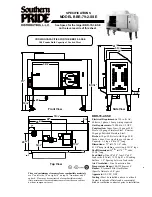
English
HS80M/HS50M/HS10W Owner’s Manual
9
R
C
LFE
RS
LS
L
30˚
30˚
100
120˚
100
120˚
Adding a Subwoofer
Even if you don’t plan to set up a surround system, adding a subwoofer can be a real advantage for stereo mixing. If you
can’t hear the extreme low end there’s not much you can do to make it sound great. The extended bass response provided
by a good subwoofer can indeed help you to improve the overall quality of your mixes.
The location of your subwoofer is not as critical as the main speakers, because frequencies below around 200 Hz — the
region your subwoofer will be working in — aren’t directional. To say it another way, the ear can’t locate the source of such
low frequencies, so in theory the subwoofer can be placed anywhere in the room. In reality it’s a good idea to place the
subwoofer on the floor somewhere between the main front speakers at the same distance from the listening position as the
main speakers, but it doesn’t have to be dead center.
Fine-tuning for Subwoofer
●
Set the HS50M or HS80M LEVEL control to about 12 o’clock to set the nominal input level to approxi4dB. If
you’re using the HS50M set the HS10W LEVEL control to about 10 o’clock, and if you’re using the HS80M set it to
about 11 o’clock. You can then fine-adjust the HS10W LEVEL control as required. Another approach would be to adjust
the HS50M/HS80M output level to achieve the desired relativebalance with the subwoofer.
●
Start with the HIGH CUT control set at its center click position, which corresponds to a HPF frequency of about 100 Hz.
The HIGH CUT frequency can be adjusted later to achieve the smoothest integration with the HS50M or HS80M
speakers.
●
Turn the HS10W LOW CUT switch ON. Adjust the LOW CUT control to achieve the desired degree of bass extension.
●
Set the HS50M/HS80M LOW CUT switch to “FLAT”.
●
When set to “-2 dB” the HS50M/HS80M EQ MID switch attenuates the midrange frequencies slightly to produce a
somewhat “softer” sound that may be better for listening or long monitoring sessions. For accurate monitoring,
however, set the MID switch to “0”.
●
Set the HS50M/HS80M ROOM CONTROL switch according to the distance your speakers are placed from the nearest
wall (refer to “Proximity to Walls and Corners”, above).
●
For accurate monitoring set the HS50M/HS80M HIGH TRIM switch to “0”. This switch can be set to “-2 dB” to
attenuate the highs slightly if you find the sound too bright.
Setting Up for Surround
If you’re going to be mixing for surround, obviously you’ll need a surround
monitoring system. For a 5.1 surround system, for example, you only need to
add a center speaker and two rear speakers to the subwoofer
system described in the previous section. Let’s see … two main speakers
plus one center speaker plus two rear speakers is a total of five
speakers, and “.1” refers to the subwoofer. All present and
accounted for!
According to the ITU (International Telecommunications Union)
specifications for 5.1 surround setup, the main front speakers are
positioned in the 60° equilateral triangle relationship to the listening
position described earlier, and the rear speakers should be located at
the same distance from the listening position, but at an angle of between


































